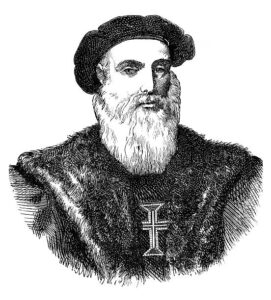
Vasco da Gama, 1st Conde da Vidigueira (born c. 1460, Sines, Portugal—died December 24, 1524, Cochin, India) was a renowned Portuguese navigator whose voyages to India (1497–99, 1502–03, 1524) opened up the sea route from western Europe to the East by way of the Cape of Good Hope.
For unknown reasons, da Gama, who had little relevant experience, was appointed by King Manuel to lead the Portuguese fleet to India to open the sea route to Asia and outflank the Arab and Italians who had hitherto enjoyed a monopoly of trade with India and other eastern state. Da Gama’s successful navigation of treacherous waters and his ability to negotiate with local rulers during his first two expeditions demonstrated his skills as a diplomat and explorer.
Until 1505 he continued to advise the King on Indian matters, and he was created count of Vidigueira in 1519. Not until after King Manuel died was he again sent overseas for the third expedition; King John III nominated him in 1524 as Portuguese viceroy in India.
Arriving in Goa in September 1524, da Gama immediately set himself to correct the many administrative abuses that had crept in under his predecessors. Whether from overwork or other causes, he soon fell ill and died in Cochin in December. In 1538 his body was taken back to Portugal.
The famed bridge named in his honor in Lisbon, the Vasco da Gama Bridge that crosses over the Tagus River estuary, spans 17.2 km (10.7 miles) and was the longest bridge in Europe at the time of its inauguration in 1998